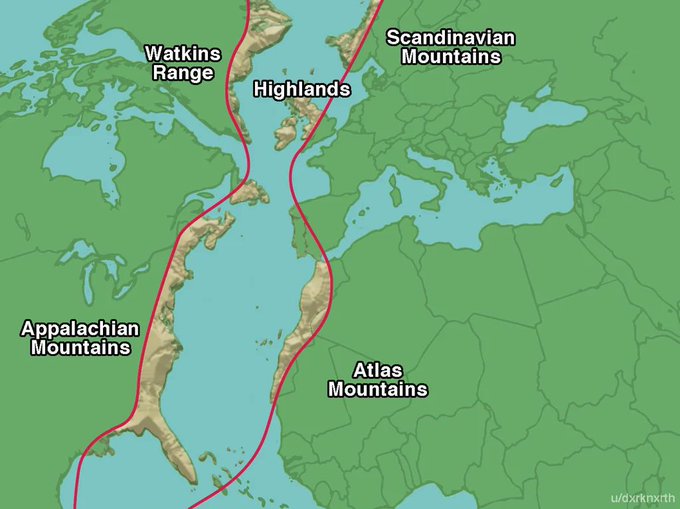The Central Pangean Mountains were an extensive mountain range that stretched from the northeast to the southwest. This range was located in the central part of the supercontinent Pangaea, existing during the Carboniferous, Permian, and Triassic periods. The mountains were the product of a collision between two large landmasses, Euramerica (also known as Laurussia) and Gondwana, which occurred during the formation of Pangaea. At its peak, during the early Permian period, the Central Pangean Mountains reached heights similar to the present-day Himalayas. Today, remnants of this colossal mountain range can still be found. For instance, in North America, we have the Appalachian Mountains and Ouachita Mountains, while in Europe, remnants include the Bohemian Massif and Massif Central. The formation of the Central Pangean Mountains involved several mountain building periods, including the Acadian, Caledonian, Alleghenian, Mauritanide, and Variscan orogenies. The eastern sections of the range are also referred to as the Variscan Mountains.
A fascinating geological fact worth noting is that the Appalachian Mountains, the Atlas Mountains, the Scottish Highlands, the Watkins Range, and the Scandinavian Mountains were all part of a unified mountain range in the past known as the Central Pangean Mountains.
Formation and decline
The majestic Central Pangean Mountains came into existence as a result of the tremendous collision between Euramerica and northern Gondwana during the Variscan and Alleghanian orogenies. This remarkable event took place approximately 340 million years ago, during the Carboniferous era, and reached its completion at the dawn of the Permian era around 295 million years ago. At its zenith, the range stood tall with its imposing peaks. However, during the Permian era, the mountains endured severe physical and mechanical erosion as a consequence of relentless weathering. As a result, the peaks were diminished by about half of their original size by the Late Permian (Lopingian), and a multitude of deep intermontane valleys emerged. As time progressed, the Central Pangean mountains underwent further reduction in size, and by the Middle Triassic era, they had noticeably shrunk. Eventually, by the early Jurassic era, which was roughly 200 million years ago, the once expansive Pangean range in Western Europe had dramatically dwindled to a few elevated regions, surrounded by vast marine basins.
Central Pangean Mountains, a majestic geological feature, hold a pivotal role in Earth’s history and continue to captivate adventurers and researchers alike. Nestled within the heart of the ancient supercontinent Pangea, these mountains boast a rich tapestry of geological wonders, biodiversity, and cultural significance.
Formation and Geological History
Formation of Pangea
Pangea, the supercontinent that existed around 335 million years ago, emerged through the gradual collision of various landmasses. The convergence of continental plates led to the formation of vast mountain ranges, including the Central Pangean Mountains.
Plate Tectonics and Mountain Building
The collision of tectonic plates resulted in immense pressure and volcanic activity, giving rise to towering peaks and rugged terrains. Over millions of years, the forces of erosion sculpted these landscapes into the awe-inspiring formations we see today.
Location and Extent
Geographical Distribution
Stretching across what is now parts of North America, Europe, Africa, and South America, the Central Pangean Mountains once formed the backbone of the supercontinent. Remnants of these ancient peaks can still be found in modern-day mountain ranges.
Major Peaks and Ranges
The Central Pangean Mountains encompassed a vast expanse of diverse terrain, including towering peaks, deep valleys, and winding rivers. Some of the prominent ranges include the Appalachians, Atlas Mountains, and Brazilian Highlands.
- Appalachian Mountains:
- Located in eastern North America, the Appalachian Mountains extend from Newfoundland in Canada to Alabama in the United States.
- Characterized by rolling hills, dense forests, and diverse wildlife, the Appalachians offer picturesque landscapes and abundant recreational opportunities.
- Renowned for the Appalachian Trail, a famous hiking route stretching over 2,000 miles through 14 states, attracting hikers and outdoor enthusiasts worldwide.
- Ouachita Mountains:
- Situated primarily in Arkansas and Oklahoma, the Ouachita Mountains form a rugged spine running east to west.
- Known for their unique geology, including quartz crystals and ancient rock formations, the Ouachitas provide a haven for rock climbers and geology enthusiasts.
- The region’s rich biodiversity includes rare plant species and endemic wildlife, making it a hotspot for conservation efforts and ecotourism.
- Bohemian Massif:
- Located in Central Europe, the Bohemian Massif encompasses parts of the Czech Republic, Germany, Austria, and Poland.
- Characterized by ancient mountain ranges and deep valleys, the Bohemian Massif offers stunning landscapes and cultural heritage sites.
- Famous for its historic towns, medieval castles, and renowned spas, the region attracts tourists seeking both outdoor adventures and cultural experiences.
- Massif Central:
- Situated in south-central France, the Massif Central is a vast upland plateau bordered by rugged mountains and deep gorges.
- Known for its volcanic landscapes, including extinct volcanoes and lava flows, the Massif Central offers unique geological formations and scenic vistas.
- The region’s rural charm, picturesque villages, and traditional cuisine make it a popular destination for hiking, cycling, and culinary tourism.
- Atlas Mountains:
- Stretching across North Africa, the Atlas Mountains form a barrier between the Mediterranean coast and the Sahara Desert.
- Characterized by rugged peaks, fertile valleys, and ancient Berber villages, the Atlas Mountains offer diverse landscapes and cultural experiences.
- Visitors can explore scenic trails, visit historic kasbahs, and immerse themselves in the rich traditions of the indigenous peoples who call this region home.
- Scottish Highlands:
- Located in northern Scotland, the Scottish Highlands are renowned for their dramatic landscapes, including rugged mountains, shimmering lochs, and sweeping glens.
- Home to iconic landmarks such as Ben Nevis, the highest peak in the British Isles, and Loch Ness, famous for its mythical monster, the Highlands attract visitors seeking adventure and natural beauty.
- The region’s rich history, Gaelic culture, and outdoor pursuits, including hiking, fishing, and wildlife watching, make it a popular destination year-round.
- Scandinavian Mountains:
- Spanning Norway, Sweden, and parts of Finland, the Scandinavian Mountains form the longest mountain range in Europe.
- Characterized by pristine wilderness, towering peaks, and deep fjords, the Scandinavian Mountains offer unparalleled opportunities for outdoor adventures.
- Visitors can experience a range of activities, from skiing and snowboarding in winter to hiking, fishing, and wildlife safaris in summer, amidst breathtaking Nordic landscapes.
- Watkins Range:
- Located in Australia’s Northern Territory, the Watkins Range is part of the rugged terrain of the MacDonnell Ranges.
- Known for its striking red rock formations, ancient Aboriginal rock art sites, and stunning desert landscapes, the Watkins Range is a haven for photographers and cultural enthusiasts.
- Visitors can explore scenic walking trails, learn about Aboriginal culture and history, and marvel at the beauty of the Australian outback.
These mountain ranges within the Central Pangean Mountains showcase the diverse geological, cultural, and recreational aspects of this ancient and awe-inspiring region.
Biodiversity and Ecosystems
Flora and Fauna
The Central Pangean Mountains supported a rich array of flora and fauna, adapted to varied climates and elevations. From lush forests teeming with diverse plant species to rugged alpine habitats inhabited by elusive wildlife, these mountains were a haven for biodiversity.
Unique Species Adaptations
Isolated by geographic barriers, many species within the Central Pangean Mountains evolved unique adaptations to survive in their respective ecosystems. From specialized camouflage to efficient energy conservation mechanisms, these evolutionary marvels continue to fascinate researchers.
Continental drift and separation of the Central Pangean Mountains
The continental drift and separation of the Central Pangean Mountains were pivotal events in Earth’s geological history, shaping the landscapes we see today.
One pretty cool geological fun fact is that the Appalachian Mountains, the Atlas Mountains, the Scottish Highlands, the Watkins Range and Scandinavian Mountains were all once part of the same mountain range, the Central Pangean Mountainshttps://t.co/6qSQIJt9KK pic.twitter.com/fUEeAoJ4wh
— Tranquil Kilimanjaro Treks (@TripKilimanjaro) April 17, 2024
As part of the supercontinent Pangea, the Central Pangean Mountains were formed through the gradual collision of continental plates over millions of years. This process, known as continental drift, involved the movement of tectonic plates across the Earth’s surface. As the plates converged, immense pressure and volcanic activity gave rise to towering mountain ranges, including the Central Pangean Mountains.
However, around 175 million years ago, the process of continental drift initiated the breakup of Pangea. As the supercontinent began to rift apart, the Central Pangean Mountains underwent significant geological changes. The once contiguous mountain ranges became fragmented as the landmasses drifted apart, eventually leading to the formation of separate continents we recognize today.
The separation of the Central Pangean Mountains occurred over millions of years as tectonic forces continued to reshape the Earth’s crust. As the continents drifted apart, ocean basins formed between them, creating new geological features and altering global climate patterns.
Today, remnants of the Central Pangean Mountains can be found scattered across multiple continents, serving as a reminder of Earth’s dynamic and ever-changing nature. The process of continental drift and the separation of these mountains have played a fundamental role in shaping the geological and biological diversity of our planet.
![]()



Comments